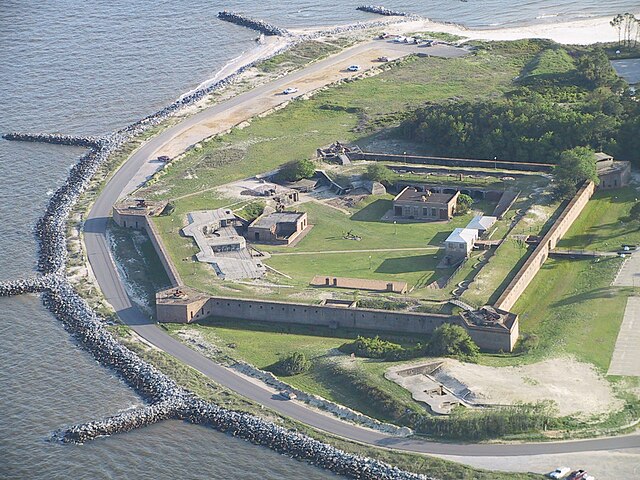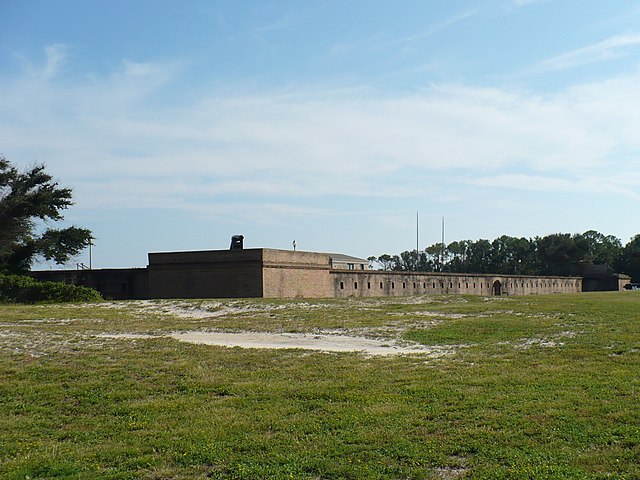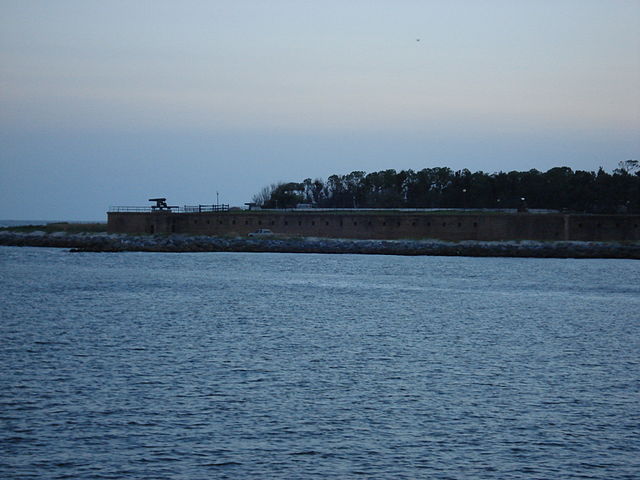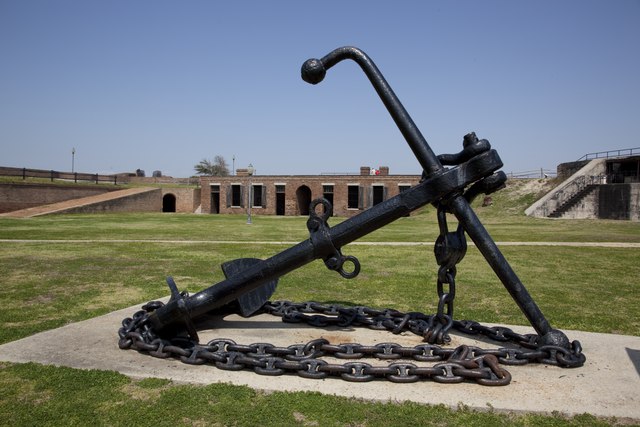Have you ever wondered what it would be like to step back in time and experience Civil War history firsthand? Fort Gaines, perched on the eastern tip of Dauphin Island, Alabama, offers exactly that opportunity. This remarkable 19th-century fortress stands as a testament to American military ingenuity and serves as a window into one of the most turbulent periods in our nation’s history.
Fort Gaines isn’t just another historic site gathering dust in the Alabama sun. It’s a living, breathing piece of history that continues to captivate visitors with its impressive architecture, fascinating exhibits, and the dramatic stories that echo through its weathered walls. Whether you’re a history buff, a family looking for an educational adventure, or simply someone who appreciates the craftsmanship of bygone eras, Fort Gaines delivers an unforgettable experience.
The Strategic Location of Fort Gaines
Why Dauphin Island Was Chosen
The selection of Dauphin Island as the site for Fort Gaines wasn’t arbitrary – it was a stroke of military genius. Located at the mouth of Mobile Bay, this barrier island commanded a perfect view of all maritime traffic attempting to enter one of the South’s most important ports. Think of it as the ultimate watchtower, positioned where it could monitor and control access to Mobile’s bustling harbor.
The island’s location provided military planners with several crucial advantages. Ships had to pass within cannon range of the fort, making it nearly impossible for enemy vessels to slip by undetected. This strategic positioning turned Fort Gaines into the guardian of Mobile Bay, a role it would play with dramatic consequences during the Civil War.
Geographic Advantages
Dauphin Island’s natural features made it an ideal fortress location. The island’s elevation provided excellent sight lines across the bay, while its narrow width meant that a relatively small garrison could effectively defend the entire position. The surrounding waters created a natural moat, making land-based attacks extremely difficult.
The island’s position also allowed for coordination with Fort Morgan, located across the bay. Together, these two fortifications created a formidable defensive network that could cross their fields of fire, creating a deadly gauntlet for any naval force attempting to enter Mobile Bay.
Historical Background and Construction

Pre-Civil War Origins
Fort Gaines traces its origins to the early 1800s, when the United States recognized the need for coastal defenses along the Gulf of Mexico. The initial planning began in the 1820s, but like many government projects, it took decades to move from concept to reality. The fort we see today represents the culmination of years of planning, engineering, and construction that spanned multiple decades.
The project gained momentum in the 1840s and 1850s as tensions between North and South began to escalate. Military engineers understood that control of Mobile Bay would be crucial in any future conflict, making the completion of Fort Gaines a matter of national security.
Building the Fort: Materials and Design
Constructing Fort Gaines was no small feat. Workers used millions of bricks, many manufactured locally, to create the fort’s distinctive red walls. The construction required incredible precision – each brick had to be perfectly placed to ensure the structural integrity of the massive walls that would need to withstand cannon bombardment.
The builders faced unique challenges working on a barrier island. All materials had to be transported by boat, and the sandy soil required special foundations to prevent settling. Despite these obstacles, the engineers created a masterpiece of 19th-century military architecture that has stood the test of time for over 150 years.
Fort Gaines During the Civil War
The Battle of Mobile Bay
August 5, 1864, marked one of the most significant naval battles in American history, and Fort Gaines played a starring role. The Battle of Mobile Bay saw Union Admiral David Farragut lead a fleet of warships past the Confederate defenses, including Fort Gaines, in a daring assault that would become legendary.
The battle wasn’t just about naval tactics – it was about controlling one of the Confederacy’s last major ports. Mobile Bay served as a crucial supply line for the Confederate war effort, and its capture would deal a devastating blow to the South’s ability to continue fighting.
Admiral Farragut’s Famous Words
During the intense fighting, Admiral Farragut reportedly shouted the immortal words, “Damn the torpedoes, full speed ahead!” This moment of courage under fire became one of the most quoted phrases in American military history. From the ramparts of Fort Gaines, Confederate defenders could see the Union fleet steaming forward despite the danger of underwater mines (then called torpedoes).
Confederate Defense Strategies
The Confederate garrison at Fort Gaines employed sophisticated defensive strategies to maximize their effectiveness against the Union assault. They coordinated their artillery fire with Fort Morgan and used the natural geography of the bay to create overlapping fields of fire that would devastate any attacking fleet.
The defenders also utilized innovative techniques like heated shot – cannonballs heated red-hot in special furnaces before firing. These projectiles were designed to set enemy ships ablaze, turning wooden warships into floating infernos.
The Siege and Surrender
Following the naval battle, Fort Gaines found itself under siege. Cut off from supplies and reinforcements, the garrison faced an impossible situation. The fort’s commander, Colonel Charles Anderson, made the difficult decision to surrender on August 8, 1864, just three days after the initial battle.
The surrender of Fort Gaines marked a turning point in the Civil War. With the fort in Union hands, Mobile Bay was effectively closed to Confederate shipping, dealing a crucial blow to the South’s war effort.
Architectural Features and Design
Bastioned Fort Design
Fort Gaines exemplifies the bastioned fort design that dominated military architecture in the 19th century. This design features angular projections called bastions that allow defenders to cover all approaches to the fort with overlapping fields of fire. It’s like having eyes in the back of your head – no enemy can approach without being seen and targeted.
The fort’s pentagonal shape maximizes defensive efficiency while minimizing the amount of wall that needs to be defended. Each angle and curve was carefully calculated to provide the best possible defensive advantage while using resources efficiently.
Casemates and Living Quarters
The interior of Fort Gaines features a series of casemates – bomb-proof chambers built into the fort’s walls. These spaces served multiple purposes: they housed cannons, provided living quarters for soldiers, and offered protection during enemy bombardments. Walking through these chambers today, you can almost hear the echoes of soldiers’ conversations and the rumble of cannon wheels on stone floors.
Daily Life Inside the Fort
Life inside Fort Gaines was a mixture of routine and tension. Soldiers spent their days maintaining equipment, standing guard duty, and preparing for the battle they knew would eventually come. The casemates provided cramped but essential living space, with soldiers sleeping on simple bunks and gathering around small fires for warmth and companionship.
Post-Civil War History
Reconstruction Era Changes
After the Civil War ended, Fort Gaines underwent significant changes. The Union Army continued to maintain a presence at the fort during Reconstruction, using it as a base for monitoring Confederate activities and maintaining order in the region. The fort’s role shifted from active defense to occupation and peacekeeping.
During this period, many of the fort’s wartime modifications were removed or altered. The intense focus on defensive preparations gave way to more routine military activities, and the fort began its slow transition from active military installation to historical artifact.
Military Deactivation
The U.S. military officially deactivated Fort Gaines in 1946, ending over a century of active service. This transition marked the beginning of the fort’s new life as a historical site, though it would take several more decades before serious preservation efforts began.
The deactivation process involved removing modern military equipment while preserving the historical structures that make Fort Gaines so fascinating today. It was like carefully peeling away layers of history to reveal the original Civil War-era fortress beneath.
Fort Gaines as a Historic Site

Preservation Efforts
Preserving Fort Gaines has been an ongoing challenge requiring dedicated effort from historians, archaeologists, and local communities. The harsh coastal environment, with its salt air and hurricane-force winds, constantly threatens the fort’s brick and mortar construction. Preservation teams work year-round to maintain the structural integrity while keeping the site authentic to its historical period.
Modern preservation techniques help protect the fort while maintaining its historical accuracy. Specialists use period-appropriate materials and methods whenever possible, ensuring that repairs and maintenance don’t compromise the fort’s historical integrity.
Educational Programs
Fort Gaines offers a variety of educational programs designed to bring history to life for visitors of all ages. These programs range from guided tours that explore the fort’s military history to hands-on demonstrations of 19th-century military life. School groups particularly benefit from these immersive experiences that make textbook history tangible and exciting.
The educational programs don’t just focus on military history – they explore the broader context of life in the 19th century, including the experiences of soldiers, civilians, and the diverse communities that called the Gulf Coast home.
Visiting Fort Gaines Today
Tourist Attractions and Activities
Today’s visitors to Fort Gaines can explore virtually every corner of this historic fortress. The self-guided tour takes you through the casemates, up onto the ramparts where cannons once roared, and into the heart of the fort where soldiers lived and worked. Each area tells a different part of the Fort Gaines story, creating a comprehensive picture of military life in the 1860s.
The fort’s location on Dauphin Island also provides spectacular views of Mobile Bay and the Gulf of Mexico. On clear days, you can see for miles across the water, giving you the same perspective that Confederate sentries had when they watched for Union ships on the horizon.
Museum Exhibits
Artifacts and Displays
The Fort Gaines museum houses an impressive collection of Civil War artifacts, many discovered during archaeological excavations at the site. These artifacts include military equipment, personal items belonging to soldiers, and fragments of the shells and bullets that flew during the Battle of Mobile Bay. Each piece tells a story about the people who lived and fought at this historic location.
The displays are carefully curated to provide context for the artifacts, helping visitors understand not just what these items are, but how they fit into the larger story of the Civil War and the defense of Mobile Bay.
Special Events and Reenactments
Throughout the year, Fort Gaines hosts special events that bring the past to life in spectacular fashion. Civil War reenactments feature period-dressed interpreters who demonstrate military drills, cannon firing, and camp life. These events transform the fort from a static historical site into a living tableau of 19th-century military life.
The annual Battle of Mobile Bay reenactment is particularly impressive, featuring both land and naval components that recreate the famous 1864 battle. Watching these events unfold gives visitors a visceral understanding of the chaos and courage that defined this pivotal moment in American history.
Getting to Fort Gaines
Transportation Options
Reaching Fort Gaines requires a bit of planning since it’s located on Dauphin Island, but the journey is part of the adventure. Most visitors drive across the Dauphin Island Bridge, which offers stunning views of Mobile Bay and the surrounding coastal landscape. The bridge itself is an impressive engineering feat that connects the island to the mainland.
For those who prefer a more scenic approach, ferry services operate seasonally between Dauphin Island and nearby coastal communities. This water-based approach gives visitors a sense of how supplies and reinforcements would have reached the fort during its active military period.
Accommodation Near Dauphin Island
Dauphin Island offers a variety of accommodation options, from historic bed-and-breakfasts to modern beach rentals. Many visitors choose to stay on the island to fully immerse themselves in the coastal atmosphere that defines this unique location. The island’s small size means that everything is within easy reach, whether you’re interested in historical sites, beaches, or local restaurants.
For those preferring more extensive amenities, Mobile and the surrounding area offer numerous hotels and resorts within a reasonable driving distance of Fort Gaines.
The Legacy of Fort Gaines

Historical Significance
Fort Gaines stands as more than just a well-preserved Civil War site – it represents a crucial chapter in American military history and the struggle that defined our nation’s character. The fort’s role in the Battle of Mobile Bay helped determine the outcome of the Civil War, making it a site of genuine national significance.
The fort also represents the ingenuity and determination of 19th-century military engineers who created defensive structures that could withstand the most advanced weapons of their time. Their work continues to impress visitors more than 150 years later.
Impact on Local Community
Fort Gaines has become an integral part of Dauphin Island’s identity and economy. The historic site attracts thousands of visitors annually, supporting local businesses and creating jobs for island residents. More importantly, it provides a connection to the past that helps current residents understand and appreciate their community’s unique place in American history.
The fort serves as an educational resource for schools throughout the region, offering students the opportunity to experience history firsthand rather than simply reading about it in textbooks.
Conclusion
Fort Gaines represents far more than weathered brick walls and silent cannons – it’s a portal to one of the most dramatic periods in American history. From its strategic construction in the antebellum period through its pivotal role in the Battle of Mobile Bay, this remarkable fortress has witnessed and shaped events that continue to resonate today.
Visiting Fort Gaines offers a unique opportunity to walk in the footsteps of history, to stand where soldiers once stood, and to gain a deeper understanding of the courage, sacrifice, and determination that defined the Civil War era. The fort’s preservation ensures that future generations will continue to learn from this tangible connection to our past.
Whether you’re drawn by military history, architectural beauty, or simply the desire to experience something truly unique, Fort Gaines delivers an unforgettable journey through time. It reminds us that history isn’t just about dates and names in textbooks – it’s about real people who faced extraordinary challenges with remarkable courage.
Frequently Asked Questions
1. How long does it take to tour Fort Gaines?
A typical visit to Fort Gaines takes 2-3 hours for a thorough exploration. This includes time to walk through all the casemates, explore the museum exhibits, and enjoy the views from the ramparts. Visitors who participate in guided tours or special programs may spend additional time at the site.
2. Is Fort Gaines suitable for children and families?
Absolutely! Fort Gaines offers excellent educational opportunities for children and features interactive exhibits designed to engage young visitors. The fort’s open design allows families to explore safely, though parents should supervise children near the ramparts and staircases.
3. What’s the best time of year to visit Fort Gaines?
Fort Gaines is open year-round, but the most comfortable visiting conditions are typically during spring and fall when temperatures are moderate. Summer visits can be quite hot, so early morning or late afternoon tours are recommended. Special events and reenactments are scheduled throughout the year.
4. Are there any ghost stories or legends associated with Fort Gaines?
Like many historic sites with dramatic histories, Fort Gaines has accumulated various ghost stories and legends over the years. While these tales add to the fort’s mystique, visitors come primarily for the well-documented historical significance rather than paranormal experiences.
5. Can I bring my own food and drinks to Fort Gaines?
Yes, visitors are welcome to bring food and drinks to enjoy in designated areas around the fort. The site has picnic areas where families can relax and enjoy meals while taking in the beautiful views of Mobile Bay. However, food and drinks are not permitted inside the museum areas or historic structures.

